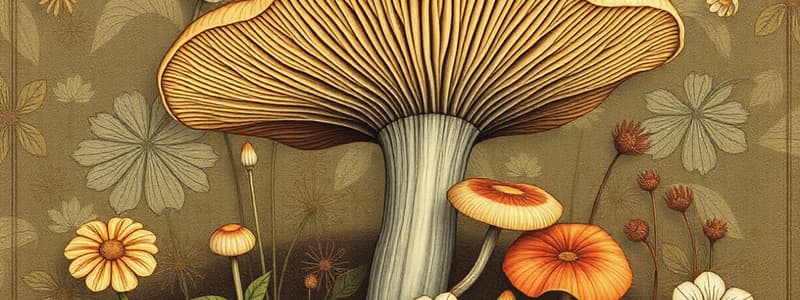Podcast
Questions and Answers
What temperature condition is specifically required for the growth of Exophiala jeanselmei?
What temperature condition is specifically required for the growth of Exophiala jeanselmei?
- 40°C to 42°C
- 37°C and 40°C
- 35°C to 37°C
- Only at 37°C (correct)
Which characteristic distinguishes Exophiala dermatitidis from Exophiala jeanselmei?
Which characteristic distinguishes Exophiala dermatitidis from Exophiala jeanselmei?
- Shape of conidiophore
- Color of colonies (correct)
- Presence of potassium nitrate
- Growth temperature
What is the shape of the conidia produced by Exophiala species?
What is the shape of the conidia produced by Exophiala species?
- Rough and irregular
- Cigar-shaped forms (correct)
- Elongated and tapered
- Round and smooth
Which method is useful for detecting melanization in fungal organisms?
Which method is useful for detecting melanization in fungal organisms?
Which of the following is true for Exophiala dermatitidis?
Which of the following is true for Exophiala dermatitidis?
Which characteristic is associated with Exserohilum?
Which characteristic is associated with Exserohilum?
What describes the appearance of Alternaria conidia?
What describes the appearance of Alternaria conidia?
What is a distinguishing feature of Curvularia?
What is a distinguishing feature of Curvularia?
Which fungi feature is described as having bent conidiophores?
Which fungi feature is described as having bent conidiophores?
Which feature is NOT characteristic of the diagnostic methods for mycoses?
Which feature is NOT characteristic of the diagnostic methods for mycoses?
Which of the following genera is identified with multiple celled and swollen central cell characteristics?
Which of the following genera is identified with multiple celled and swollen central cell characteristics?
What feature is crucial in identifying exophiala species?
What feature is crucial in identifying exophiala species?
Which description accurately completes the identification of Bipolaris?
Which description accurately completes the identification of Bipolaris?
Which species is known for having a cleistothecial structure in its sexual form?
Which species is known for having a cleistothecial structure in its sexual form?
What is the typical characteristic of the conidia produced by Cladophialophora?
What is the typical characteristic of the conidia produced by Cladophialophora?
Which of the following best describes the infection caused by eumycotic mycetomas?
Which of the following best describes the infection caused by eumycotic mycetomas?
Which genus is associated with branching, single-celled conidiophores?
Which genus is associated with branching, single-celled conidiophores?
In which regions are eumycotic mycetomas most commonly found?
In which regions are eumycotic mycetomas most commonly found?
Which of the following conidia measurements is typical for Phialophora?
Which of the following conidia measurements is typical for Phialophora?
Which characteristic is NOT associated with Rhinocladiella aquaspersa?
Which characteristic is NOT associated with Rhinocladiella aquaspersa?
What type of infection is primarily caused by fungi in those with outdoor occupations?
What type of infection is primarily caused by fungi in those with outdoor occupations?
Flashcards are hidden until you start studying
Study Notes
Exophiala
- Exophiala jeanselmei is a slow growing fungus that produces shiny brown, velvety colonies with age
- It has elongated conidiophores with tapered tips, utilizes potassium nitrate, and grows only at 37°C
Exophiala dermatitidis
- Slow grower
- Produces shiny black colonies that appear velvety with age
- Has elongated tubular annellophores
- Does not use potassium nitrate
- Grows at 37°C, 40°C, and 42°C
Conidia of Exophiala spp.
- Conidia bud at the tips of annelides
Conidia of Exophiala dermatitidis
- Yeast form: 2 to 4 μm in diameter, oval or elliptical in shape, often with a single bud
- Cigar-shaped forms measuring 3 to 10 μm
Yeast & Mold Phases of S. dermatitidis
- Colonies are gray-green to dark-brown
Dematiaceous Genera Inciting Subcutaneous Phaeohyphomycosis
- Exserohilum: Gray-green to dark brown colonies
- Alternaria: Golden-brown hyphae, large brown conidia resembling a drumstick, with horizontal and longitudinal septa
Cleistothecia Containing Ascospores
- Appear as a drumstick with alternating dark and light horizontal and longitudinal septa
Curvularia
- Geniculate conidiophores
- Conidia: Golden-brown, multi-celled, curved, and have a swollen central cell
Bipolaris
- Bent conidiophores
- Oblong conidia arranged sympodially
- Hilum protrudes slightly
- Germ tubes present at one or both ends
Cladophialophora carrionii
- Erect conidiophore
- Single celled and branching
Rhinocladiella aquaspersa
- Erect conidiophore
- Dark in color, conidia located only on the upper portion near the tip of conidiophore
- Elliptical, single-celled, and sympodially arranged
Phialophora vs. Cladophialophora
- Phialophora: Conidia measure 3-5 by 1.5-3.5 micrometers, aggregated and clustered at the apices of the phialide
- Cladophialophora: Lemoniform to fusiform, smooth, slightly verrucous, pale olivaceous
Phialophora verrucosa
- Flask-shaped phialide
- Collar-like structure (colorette)
- Conidia
Eumycotic Mycetomas
- Uncommon in the United States
- Subcutaneous and cutaneous tissue infections
- Swelling and exudates draining to the skin surface
- Mostly found in tropical and subtropical areas
- Infections occur in individuals with outdoor occupations
- Chronic granulomatous infection, commonly involving the lower extremities
- Dissemination may occur, but it is rare
- Most common:
- Pseudallescheria boydii (teleomorph): Sexual form, cleistotheicia
- Scedosporium boydii(anamorph): Asexual form, single oval conidia
Studying That Suits You
Use AI to generate personalized quizzes and flashcards to suit your learning preferences.
